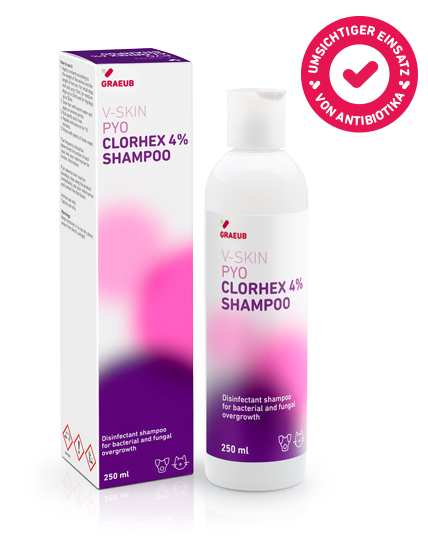HAUTINFEKTIONEN BEI HUNDEN UND KATZEN
HAUTINFEKTIONEN BEI HUNDEN UND KATZEN
V-SKIN
PYO
CLORHEX 4% SHAMPOO
Eine wirksame topische Behandlung ist der Schlüssel zur Bekämpfung von bakteriellen und Pilzinfektionen der Haut bei Katzen und Hunden.
Clorhex 4 % Shampoo hat antiseptische, antibakterielle und antimykotische Eigenschaften zur Reinigung der Haut und von Wunden bei Dermatitis und Pyodermie.
Es ist sulfatfrei und enthält ein hypoallergenes Parfüm, um trockener Haut entgegenzuwirken und die Haut Ihres Haustieres zu pflegen. Mit einer sehr milden natürlichen Seife aus Kokosnussöl, die das Fell sauber und weich hält.

Wichtige Punkte:
- Mit Chlorhexidin, einem wirksamen antibakteriellen, desinfizierenden und antiseptischen Inhaltsstoff.1, 2, 3, 4
- Tris-EDTA: Antibiofilm-Bestandteil, der die Wirkung von Chlorhexidin verstärkt.5, 6, 7
- Aloe Vera und calendula zur Beruhigung der betroffenen Haut.8, 9, 10, 11, 12, 13, 14, 15, 16, 17, 18
Art und Weise der Anwendung:
- Eine Menge auftragen, die für das Gewicht des Tieres und die Länge der Haare angemessen ist.
- Die Haare mit warmem Wasser spülen und das Shampoo an mehreren Stellen auftragen.
- Sanft einmassieren und abspülen.
- Diesen Schritt wiederholen und das Shampoo 10 Minuten einwirken lassen.
- Mit reichlich sauberem Wasser abspülen.
- Die Häufigkeit sollte je nach Einzelfall festgelegt werden.
- Konsultieren Sie Ihren Tierarzt.
- Augenkontakt vermeiden.
Sehen Sie sich das Video zur Produktanwendung an!
Meinungen von Tierärzten
Angenehmer Geruch, hinterlässt ein flauschiges Haar und Hautrötungen werden nach der Anwendung gelindert.

Literatur
- Mueller, R. S., Bergvall, K., Bensignor, E., & Bond, R. (2012). A review of topical therapy for skin infections with bacteria and yeast. Veterinary Dermatology, 23(4).
https://doi.org/10.1111/j.1365-3164.2012.01057.x - Denny, J., & Munro, C. L. (2017). Chlorhexidine Bathing Effects on Health-Care-Associated Infections. Biological Research for Nursing, 19(2).
https://doi.org/10.1177/1099800416654013 - Esumi, M., Kanda, S., Shimoura, H., Hsiao, Y. H., & Iyori, K. (2021). Preliminary evaluation of two bathing methods for the management of Malassezia overgrowth in dogs with atopic dermatitis. Veterinary Dermatology, 32(3).
https://doi.org/10.1111/vde.12948 - Wan, J. (2014). A case of methicillin-resistant Staphylococcus pseudintermedius (MRSP) pyoderma in a Labrador retriever dog. Canadian Veterinary Journal, 55(11).
- Swanson, E. A., Freeman, L. J., Seleem, M. N., & Snyder, P. W. (2014). Biofilm-infected wounds in a dog. Journal of the American Veterinary Medical Association, 244(6).
https://doi.org/10.2460/javma.244.6.699 - Wooley, R. E., & Jones, M. S. (1983). Action of EDTA-Tris and antimicrobial agent combinations on selected pathogenic bacteria. Veterinary Microbiology, 8(3).
https://doi.org/10.1016/0378-1135(83)90079-2 - Buckley, L. M., Mcewan, N. A., & Nuttall, T. (2013). Tris-EDTA significantly enhances antibiotic efficacy against multidrug-resistant Pseudomonas aeruginosa in vitro. Veterinary Dermatology, 24(5).
https://doi.org/10.1111/vde.12071 - Hekmatpou, D., Mehrabi, F., Rahzani, K., & Aminiyan, A. (2019). The effect of aloe vera clinical trials on prevention and healing of skin wound: A systematic review. In Iranian Journal of Medical Sciences (Vol. 44, Issue 1).
- Sánchez, M., González-Burgos, E., Iglesias, I., & Gómez-Serranillos, M. P. (2020). Pharmacological update properties of aloe vera and its major active constituents. In Molecules (Vol. 25, Issue 6).
https://doi.org/10.3390/molecules25061324 - Teplicki, E., Ma, Q., Castillo, D. E., Zarei, M., Hustad, A. P., Chen, J., & Li, J. (2018). The effects of aloe vera on wound healing in cell proliferation, migration, and viability. Wounds, 30(9).
- Kamr, A., Arbaga, A., El-Bahrawy, A., Elsify, A., Khaled, H., & Hassan, H. (2020). The therapeutic efficacy of Aloe vera gel ointment on staphylococcal pyoderma in dogs. Veterinary World, 13(11).
https://doi.org/10.14202/VETWORLD.2020.2371-2380 - Arbaga, A., El-Bahrawy, A., Elsify, A., Khaled, H., Hassan, H. Y., & Kamr, A. (2021). Biochemical and histopathological changes related to the topical application of Aloe vera ointment for canine pyoderma. Veterinary World, 14(5).
https://doi.org/10.14202/vetworld.2021.1354-1362 - Preethia, K. C., Kuttanb, G; Kuttan, R. (2009). Anti-inflammatory activity of flower extract of Calendula officinalis Linn. and its possible mechanism of action. Indian Journal of Experimental Biology 2009 47(2).
- Tresch, M., Mevissen, M., Ayrle, H., Melzig, M., Roosje, P.; Walkenhorst, M. (2019). Medicinal plants as therapeutic options for topical treatment in canine dermatology? A systematic review. BMC Veterinary Researc, (1).
https://doi.org/10.1186/s12917-019-1854-4 - Giostri, G. S., Novak, E. M.; Guarita-Souza, L. C. (2021). Treatment of acute wounds in hand with Calendula officinalis L.: A randomized trial. Tissue Barriers.
https://doi.org/10.1080/21688370.2021.1994822 - Cruceriu, D., Balacescu, O; Rakosy, E. (2018). Calendula officinalis: Potential Roles in Cancer Treatment and Palliative Care. In Integrative Cancer Therapies (Vol. 17, Issue 4, pp. 1068–1078). SAGE Publications Inc.
https://doi.org/10.1177/1534735418803766 - Lima, M. dos R., Lopes, A. P., Martins, C., Brito, G. A. C., Carneiro, V. C; Goes, P. (2017). The effect of Calendula officinalis on oxidative stress and bone loss in experimental periodontitis. Frontiers in Physiology, (JUN).
https://doi.org/10.3389/fphys.2017.00440 - John, R.; Jan, N. (2017). Calendula Officinalis-An Important Medicinal Plant with Potential Biological Properties.Proceedings of the Indian National Science Academy,(0).
https://doi.org/10.16943/ptinsa/2017/49126


 Wir verwenden Cookies auf unserer Website, um Ihre Präferenzen und wiederholten Besuche zu speichern und Ihnen so ein optimales Erlebnis zu bieten. Durch Anklicken von "Alle akzeptieren" erklären Sie sich mit der Verwendung ALLER Cookies einverstanden. Sie können jedoch unter "Cookie-Einstellungen" eine kontrollierte Zustimmung erteilen.
Wir verwenden Cookies auf unserer Website, um Ihre Präferenzen und wiederholten Besuche zu speichern und Ihnen so ein optimales Erlebnis zu bieten. Durch Anklicken von "Alle akzeptieren" erklären Sie sich mit der Verwendung ALLER Cookies einverstanden. Sie können jedoch unter "Cookie-Einstellungen" eine kontrollierte Zustimmung erteilen.